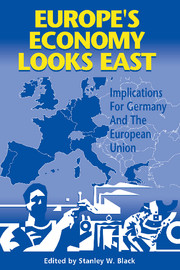Preface
Published online by Cambridge University Press: 03 February 2010
Summary
Economic relations between the European Union (EU) and the countries of Central and Eastern Europe (CEECs) underpin hopes for stability on the continent after the Cold War. The EU plays a central role in Europe's emerging architecture. In May 1995 the European Commission presented its White Paper, Preparation of the Associated Countries of Central and Eastern Europe for Integration into the Internal Market of the Union. The document specified the steps the CEECs were required to take to adapt to the acquis communautaire, focusing on twenty-three separate areas of legislative activity from free movements of goods, services, capital, and labor, to social policy and agriculture. Germany plays a central role in establishing the economic ligature between East and West by virtue of its location, economic magnitude, and experience with unification. CHonsensus reigns across all parties represented in the German Bundestag that CEEC membership is a vital German interest. In an effort to contribute to a better understanding of the forces at work between the two halves of Europe, the Economic Studies Program of the American Institute for Contemporary German Studies commissioned a set of papers that were discussed at the Institute conference “Europe's Economy Looks East: Implications for Germany and the EU, ” held in May 1995. This volume presents the papers, together with an introduction by Stanley W. Black, the Director of the Economic Studies Program.
The American Institute for Contemporary German Studies at The Johns Hopkins University is committed to advanced research, study, and discussion of the Federal Republic of Germany.
- Type
- Chapter
- Information
- Europe's Economy Looks EastImplications for Germany and the European Union, pp. xiii - xivPublisher: Cambridge University PressPrint publication year: 1997

